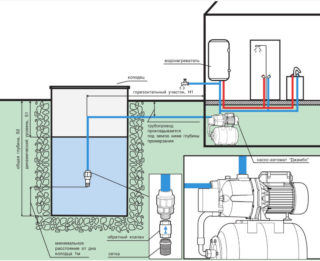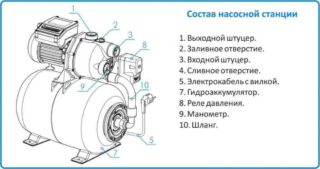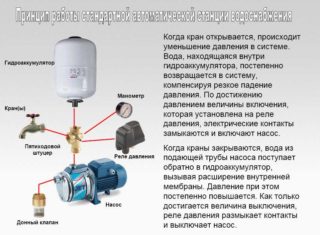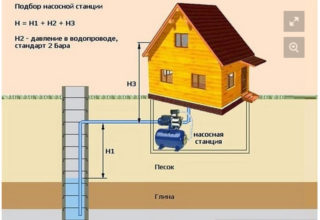To provide a private house with water at any time of the day, you need to buy and install an automatic pumping station for domestic water supply. If you look into the construction supermarket, you can see many models and brands. It is possible to determine which one to choose only after a detailed study of the technical characteristics, reviews and conditions at the site where the well or well is located.
NS device
- a surface pump pumps water through a pipe or hose;
- a hydroaccumulator with a rubber bulb inside stores it in reserve;
- the motor drives the pump;
- the pressure switch detects and controls the moment when it is necessary to turn on or turn off the equipment.
Depending on how the relay settings are made, the station will turn on and off more or less frequently. The service life depends on the number of on / off cycles, therefore, if you wish, it is better to configure the device, you should take into account how many times a day it will work.
The principle of operation of an automatic water supply station
The pump starts pumping water from the well after the pressure in the membrane tank drops, that is, some plumbing fixture is turned on in the house - a faucet in the kitchen, bathroom, shower, washing machine or dishwasher. When water is drawn into the accumulator and the pressure gauge shows the upper limit of the pressure settings, the unit turns off automatically.
Advantages and disadvantages
As with any equipment, pumping stations have their positive and negative sides. The positive ones include:
- automatic mode - the unit does not require constant monitoring;
- you can choose a pump depending on the needs of the family so as not to overpay for performance;
- the presence of storage capacity increases the resource of the station, since it does not work in a constant mode;
- maintaining a constant pressure in the system, which is important for most household appliances and plumbing fixtures;
- on many modern water supply units there are several degrees of protection at once, as well as a check valve against draining water and filters from clogging and damage to internal parts.
Cons:
- the unit makes noise during operation, so it is better not to put it in a living room, a basement or a shed, preferably warm, is suitable, so that less condensation forms, due to which the body quickly rusts;
- if the productivity of the well is less than the productivity of the pump, there will be constant interruptions in water in the house;
- the station operates at a limited depth of up to 8 meters, therefore it is not suitable for all wells;
- devices with all levels of protection are expensive, so you won't be able to save money on the purchase;
- if you buy silent equipment for installation in your home, it will cost even more.
Before thinking about buying a pumping station, you need to check whether the conditions in which it will work are suitable.It may be worth considering a submersible or surface pump of low power, which corresponds to the depth and capacity of the source.
Criterias of choice
First of all, this is the performance of the unit: how many cubic meters of liquid it can pump over a certain unit of time. This indicator directly depends on the power consumed by the engine.
The second point is the head - the size of the water column. Here you need to know the exact length of the entire line from the well to the draw-off point in the house. The value is determined in meters of water column, while horizontally 10 m is equal to 1 meter vertically. To calculate correctly whether a pumping station with a certain pressure is suitable for a site, you need to measure the depth of the well, to this number add the vertical length of the pipeline divided by 10. For example: the depth of the well is 4 meters, the length of the vertical section of the pipe is 30 m. 4 + 3 = 7 m. For this situation, you need a station with a water pressure of at least 7 m of water column.
The levels of protection are of great importance - from idle operation (dry running), filters, overheating sensors, a check valve. If the water level suddenly drops in the well, the station will not turn on until the suction pipe is lowered below. On the one hand, it will take time to find out the reason for the equipment failure, on the other hand, it will save the device from breakdown. Protected pumps are more expensive but last longer.
It plays a role which brand / manufacturer to choose for long-term work. Cheap equipment is absolutely not suitable for long-term operation. All parts of such devices are made of plastic, so they wear out quickly. The most popular are Italian and German brands, but they are expensive, as they have increased quality characteristics. You can also find good devices among the Chinese models, but they will not be cheap. The best option is expensive domestic models. They are cheaper than Italian and German ones, but they are made with high quality.
For deep wells, the installation of a pumping station with an ejector is required, without which it will be impossible to raise water from a depth of more than 10 m. This is expensive equipment. With a limited budget, you should think about buying a simple submersible pump and installing a storage tank.
Installation and operation

Installation of a pumping station takes a minimum of time if you plan to install it in a prepared room. If you need to equip a caisson near the well, it will take more time and additional costs. It is necessary to make a concrete cushion for the equipment, fix it, and then connect it to the rest of the line.
To connect to a household wiring, the pump must be connected to an outdoor piping. Thanks to the convenient manifold, this is easy to do. After the pipes are laid and connected, the first start-up is carried out. At the same time, it is impossible to fill up the trenches, since the highway may need to be reworked. After checking with the plumbing fixtures on in the house, it is recommended to leave the trenches open for a couple of days. If no failures are observed during this time, the highway is covered with earth and tamped.
NS cost
Prices for automatic pumping stations for a private house depend primarily on the capacity and performance of the equipment, then on the availability of protective devices and sensors. Ejector units are more expensive, but can be used at greater depths.
Imported models have proven themselves well in the domestic market due to constant quality control at all stages of production, as well as the use of expensive materials.











